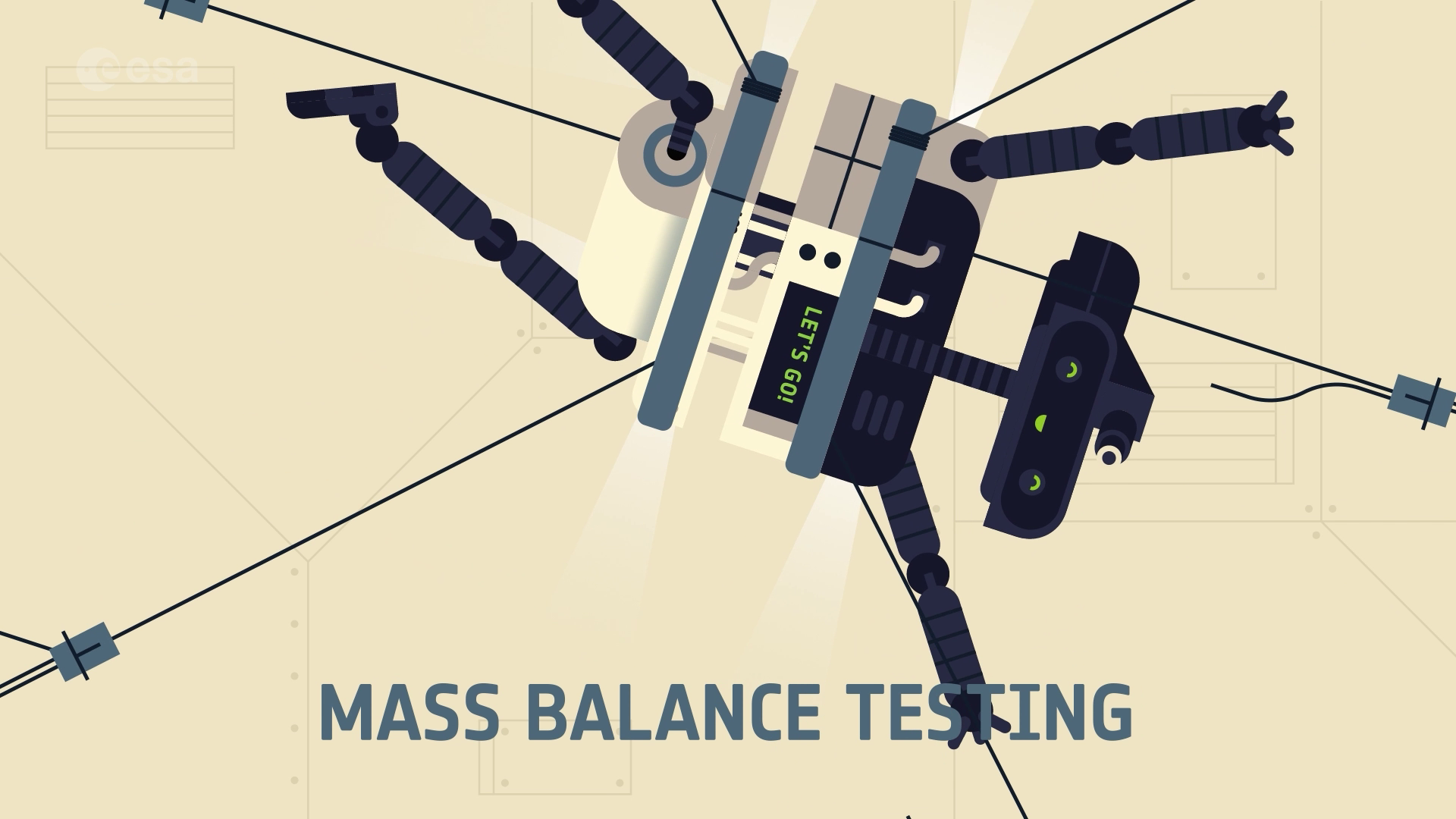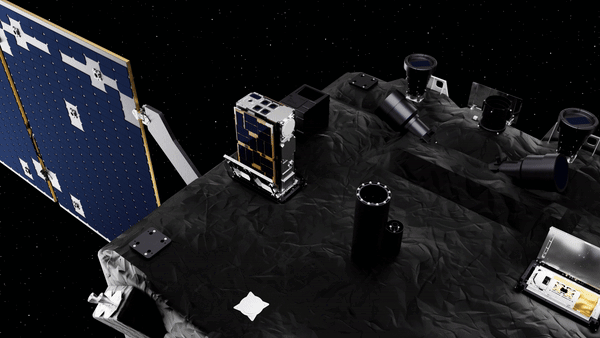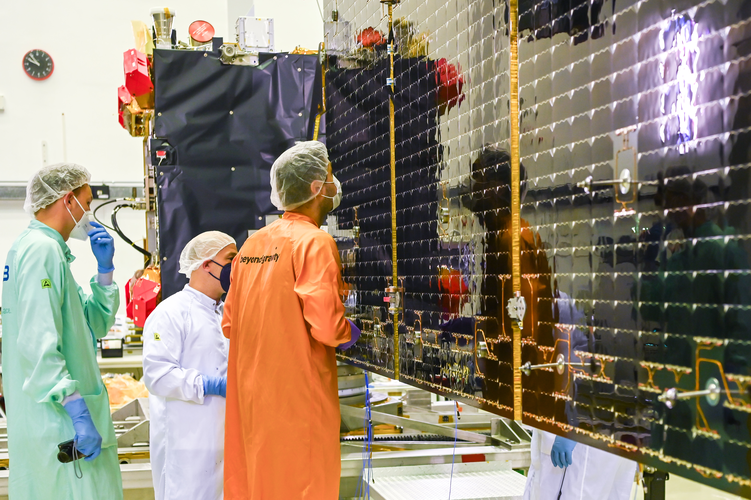Glimpses of Hera’s target asteroids inspire new science
As ESA’s Hera mission for planetary defence completes its pre-launch testing, its target asteroids have come into focus as tiny worldlets of their own. A special issue of Nature Communications published this week presents studies of the Didymos asteroid and its Dimorphos moon, based on the roughly five and a half minutes of close-range footage returned by NASA’s DART spacecraft before it impacted the latter body – along with post-impact images from the Italian Space Agency’s LICIACube.

First planetary defence test
On 26 September 2022 NASA’s approximately half-tonne Double Asteroid Redirect Test, DART, spacecraft impacted the boulder covered Dimorphos asteroid at a speed of 6.1 km/s.
Humankind’s first experiment in the kinetic impact method of asteroid deflection was successful to a surprising degree: the orbit of Dimorphos around Didymos was shortened by more than half an hour - at the upper end of predictions – observed from Earth as well as from DART’s accompanying LICIACube.
Scientists are still not sure why the impact occurred the way it did, so have been busy studying all available data, in a bid to better understand the process of kinetic impact for planetary defence, as well as the underlying nature of asteroids.

The images from DART’s DRACO camera plus LICIACube represent one of the most important data sources – until ESA’s Hera mission, which lifts off this October, reaches Didymos for its own close-up study in late 2026 to fill the remaining gaps in information, to provide a full picture of the DART impact.
“The amount of knowledge gained out of the brief few minutes of images returned by DART and LICIACube has turned out to be extraordinary,” notes Hera Principal Investigator Patrick Michel, Director of Research at CNRS at Observatoire de la Côte d'Azur, “This imagery contributed to more than 80 published scientific papers to date!”

International science efforts
The papers in this week’s’s Nature Communications were a collaboration between the Johns Hopkins Applied Physics Laboratory (APL) in Maryland, USA – which developed and led DART for NASA – together with several European research bodies including Italy’s National Institute for Astrophysics, INAF and France’s Institut Supérieur de l'Aéronautique et de l'Espace, ISAE-Supaero, part of the University of Toulouse.
Through painstaking analysis of DART and LICIACube imagery, the five papers chart key surface characteristics of the two bodies to make various findings about the nature and likely origins of the asteroid pair.

One APL-led paper uses these inputs to model the age and origin of the two bodies: the mountain-sized Dimorphos asteroid has a surface age 40–130 times older than its Great Pyramid-sized Dimorphos moon, with the former estimated to be 12.5 million years, which corresponds to the mean lifetime of Near-Earth objects, and the latter less than 300 000 years old (making it roughly the same age as Homo sapiens here on Earth).
This suggests that the formation of Dimorphos is very recent in the history of the asteroid system, unless some re-surfacing occurred that erased former craters and reset the clock used to estimate its age.

Comparing the topography and boulder distribution of the two asteroids suggest that Dimorphos was created by Didymos – which is the fastest spinning asteroid yet visited by humankind – undergoing a ‘mass shedding event’ of material into space. The mapping effort shows that while Didymos is rocky at higher elevations, it is smoother around its equator, from where shedding would have occurred.
Maurizio Pajola, of INAF and co-authors led a paper comparing the shapes and sizes of the various boulders and their distribution patterns on the two asteroids’ surfaces. They determined the physical characteristics of Dimorphos indicate it formed in stages, likely of material inherited from its parent asteroid Didymos – consistent with the conclusion of the previous paper.

Something moving on the surface
Alice Lucchetti, also of INAF, and colleagues found that thermal fatigue — the gradual weakening and cracking of a material caused by heat — can rapidly break up boulders on the surface of Dimorphos, more rapidly generating very fine surface dust and altering the physical characteristic of asteroids like Didymos than previously thought.
A paper led by two Masters in Aerospace Engineering students – Jeanne Bigot and Pauline Lombardo from ISAE-SUPAERO supervised by researcher Naomi Murdoch and colleagues – traced tracks left by boulders moved by gravity towards the equator to determine that Didymos’ bearing capacity — its surface’s ability to support applied loads — is at least 1 000 times lower than that of dry sand on Earth or lunar soil. This is considered an important parameter for understanding and predicting the response of a surface, including for the purposes of landing on an asteroid.

Such a low surface strength was also found for the last two near-Earth asteroids visited by space probes, Bennu and Ryugu by NASA's OSIRIS-REx and JAXA's Hayabusa2 mission, respectively. That poses the question whether low surface strength is a common characteristic of small asteroids. Ultimately other missions would be needed to interact with them to determine whether they in fact have diverse mechanical properties or else actually share this common weakness. Answering this question has strong implications for planetary defence.
Colas Robin and Alexia Duchene, two PhD students from ISAE-SUPAERO also supervised by researcher Naomi Murdoch, and co-authors analysed the detailed shapes of surface boulders on Dimorphos, comparing them with those on other small rubble pile asteroids surveyed by spacecraft: Itokawa, Ryugu and Bennu. The researchers found the boulders shared similar characteristics, suggesting all these types of asteroids formed and evolved in a similar fashion. The team also noted that “the elongated nature of the boulders around the DART impact site implies that they were likely formed through impact processing”.
DART and Hera team member Naomi Murdoch explains: ““Planetary defense efforts heavily rely on understanding the physical properties of asteroids. In these five papers, we have used images from the DART mission, combined with various methodologies, to provide vital information about the surface material and strength of these asteroids, enhancing our ability to protect Earth from potential threats while simultaneously unravelling the history and evolution of Didymos and Dimorphos.”

2026: dateline for Hera arrival
Once it reaches the Didymos system in late 2026, Hera will perform a close-up survey of the post-impact Dimorphos while also acquiring data on Didymos. The spacecraft will also release a pair of shoebox-sized CubeSats for complementary observations, including the first radar survey within an asteroid. Hera will therefore enable improved versions of the analyses performed in these papers
Patrick Michel comments: “Hera will document fully all required characteristics of the binary system as well as the DART impact outcome. So Hera and DART together will deliver the first fully documented asteroid deflection test. This is fundamental for the validation of numerical impact models at actual asteroid scale and their application to other scenarios as well as for the assessment of the efficiency of the kinetic impactor technique.”
The mission is being supported by the international Hera Science Working Groups.
Hera is currently completing its test campaign at ESA’s ESTEC Test Centre in the Netherlands, in preparation for transport to Cape Canaveral at the beginning of September for launch by SpaceX Falcon 9 the following month.


Access the video














 Germany
Germany
 Austria
Austria
 Belgium
Belgium
 Denmark
Denmark
 Spain
Spain
 Estonia
Estonia
 Finland
Finland
 France
France
 Greece
Greece
 Hungary
Hungary
 Ireland
Ireland
 Italy
Italy
 Luxembourg
Luxembourg
 Norway
Norway
 The Netherlands
The Netherlands
 Poland
Poland
 Portugal
Portugal
 Czechia
Czechia
 Romania
Romania
 United Kingdom
United Kingdom
 Slovenia
Slovenia
 Sweden
Sweden
 Switzerland
Switzerland









































